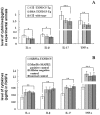Investigate pathogenic mechanism of TXNDC5 in rheumatoid arthritis
- PMID: 23326410
- PMCID: PMC3541148
- DOI: 10.1371/journal.pone.0053301
Investigate pathogenic mechanism of TXNDC5 in rheumatoid arthritis
Abstract
Hypoxia stimulates synovial hypoperfusion in rheumatoid arthritis (RA). TXNDC5 stimulates cellular proliferation in hypoxic conditions. We previously detected increased TXNDC5 expression in synovial tissues and blood from RA patients and demonstrated that the gene encoding TXNDC5 increased RA risk. The present study investigated the pathogenic roles of TXNDC5 in RA. Transgenic mice that over-expressed TXNDC5 (TXNDC5-Tg) were generated using C57BL/6J mice and treated with bovine collagen II to induce arthritis (CIA). Synovial fibroblasts from RA patients (RASFs) were cultured and incubated with TXNDC5-siRNA or CoCl(2), a chemical that induces hypoxia. CIA was observed in 80% of the TXNDC5-Tg, but only 20% of the wild-type mice (WT) developed CIA. The clinical arthritis scores reached 5 in the TXNDC5-Tg, but this index only reached 2 in the control mice. CIA TXNDC5-Tg exhibited clear pannus proliferation and bone erosion in joint tissues. A significant increase in CD4 T cells was observed in the thymus and spleen of TXNDC5-Tg during CIA. Serum levels of anti-collagen II IgG, IgG1 and IgG2a antibodies were significantly elevated in the mice. Increased cell proliferation, cell migration and TXNDC5 expression were observed in RASFs following incubation with 1 µM CoCl(2). However, this effect was diminished when TXNDC5 expression was inhibited with 100 nM siRNA. TNF-alpha, IL-1α, IL-1β and IL-17 levels were significantly increased in the blood of TXNDC5-Tg mice, but the levels of these cytokines declined in the supernatant of RASFs that were treated with TXNDC5 siRNA. The expression of adiponectin, a cytokine-like mediator, decreased significantly in RASFs following TXNDC5 siRNA treatment. These results suggest that TXNDC5-over-expressing mice were susceptible to CIA. This study also suggests that hypoxia induced TXCNDC5 expression, which contributed to adiponectin expression, cytokine production and the cellular proliferation and migration of fibroblasts in RA.
Conflict of interest statement
Figures






Similar articles
-
TXNDC5 contributes to rheumatoid arthritis by down-regulating IGFBP1 expression.Clin Exp Immunol. 2018 Apr;192(1):82-94. doi: 10.1111/cei.13080. Epub 2017 Dec 21. Clin Exp Immunol. 2018. PMID: 29131315 Free PMC article.
-
CD5L aggravates rheumatoid arthritis progression via promoting synovial fibroblasts proliferation and activity.Clin Exp Immunol. 2023 Oct 13;213(3):317-327. doi: 10.1093/cei/uxad054. Clin Exp Immunol. 2023. PMID: 37191481 Free PMC article.
-
Adiponectin aggravates bone erosion by promoting osteopontin production in synovial tissue of rheumatoid arthritis.Arthritis Res Ther. 2018 Feb 8;20(1):26. doi: 10.1186/s13075-018-1526-y. Arthritis Res Ther. 2018. PMID: 29422077 Free PMC article.
-
CXCL10 and TRAIL Are Upregulated by TXNDC5 in Rheumatoid Arthritis Fibroblast-like Synoviocytes.J Rheumatol. 2018 Mar;45(3):335-340. doi: 10.3899/jrheum.170170. Epub 2017 Dec 15. J Rheumatol. 2018. PMID: 29247155
-
TXNDC5 synergizes with HSC70 to exacerbate the inflammatory phenotype of synovial fibroblasts in rheumatoid arthritis through NF-κB signaling.Cell Mol Immunol. 2018 Jul;15(7):685-696. doi: 10.1038/cmi.2017.20. Epub 2017 Jun 26. Cell Mol Immunol. 2018. PMID: 28603283 Free PMC article.
Cited by
-
A critical role of the thioredoxin domain containing protein 5 (TXNDC5) in redox homeostasis and cancer development.Genes Dis. 2018 Sep 28;5(4):312-322. doi: 10.1016/j.gendis.2018.09.003. eCollection 2018 Dec. Genes Dis. 2018. PMID: 30591932 Free PMC article. Review.
-
The role and mechanism of TXNDC5 in disease progression.Front Immunol. 2024 Apr 2;15:1354952. doi: 10.3389/fimmu.2024.1354952. eCollection 2024. Front Immunol. 2024. PMID: 38629066 Free PMC article. Review.
-
The novel role of ER protein TXNDC5 in the pathogenesis of organ fibrosis: mechanistic insights and therapeutic implications.J Biomed Sci. 2022 Sep 2;29(1):63. doi: 10.1186/s12929-022-00850-x. J Biomed Sci. 2022. PMID: 36050716 Free PMC article. Review.
-
Mitochondrial Dysregulation Secondary to Endoplasmic Reticulum Stress in Autosomal Dominant Tubulointerstitial Kidney Disease - UMOD (ADTKD-UMOD).Sci Rep. 2017 Feb 21;7:42970. doi: 10.1038/srep42970. Sci Rep. 2017. PMID: 28220896 Free PMC article.
-
TXNDC5 contributes to rheumatoid arthritis by down-regulating IGFBP1 expression.Clin Exp Immunol. 2018 Apr;192(1):82-94. doi: 10.1111/cei.13080. Epub 2017 Dec 21. Clin Exp Immunol. 2018. PMID: 29131315 Free PMC article.
References
-
- Nakamura H (2004) Thioredoxin as a key molecule in redox signaling. Antioxid Redox Signa l6: 15–17. - PubMed
-
- Sullivan DC, Huminiecki L, Moore JW, Boyle JJ, Poulsom R, et al. (2003) EndoPDI, a novel protein-disulfide isomerase-like protein that is preferentially expressed in endothelial cells acts as a stress survival factor. J Biol Chem 278: 47079–47088. - PubMed
-
- Chang X, Cui Y, Zong M, Zhao Y, Yan X, et al. (2009) Identification of proteins with increased expression in rheumatoid arthritis synovial tissues. J Rheumatol 36: 872–880. - PubMed
Publication types
MeSH terms
Substances
LinkOut - more resources
Full Text Sources
Other Literature Sources
Medical
Molecular Biology Databases
Research Materials
Miscellaneous

